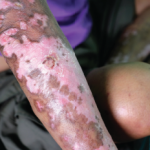 A new review article in Arthritis & Rheumatology was written by two experts on Sjögren’s disease, Rachael Gordon, MD, PhD, an assistant professor of medicine in the Division of Rheumatology and director of the UPMC Sjögren’s Center, University of Pittsburgh School of Medicine, and Sara McCoy, MD, PhD, an assistant professor of medicine in the Division of Rheumatology, School of Medicine and Public Health, University of Wisconsin-Madison.
A new review article in Arthritis & Rheumatology was written by two experts on Sjögren’s disease, Rachael Gordon, MD, PhD, an assistant professor of medicine in the Division of Rheumatology and director of the UPMC Sjögren’s Center, University of Pittsburgh School of Medicine, and Sara McCoy, MD, PhD, an assistant professor of medicine in the Division of Rheumatology, School of Medicine and Public Health, University of Wisconsin-Madison.
The authors explore the expanding field of endotyping for Sjögren’s disease as a tool to enhance patient stratification, prognostication and clinical decision making. The authors say endotypes of Sjögren’s disease driven by heightened B cell activity are linked to an increased risk of lymphoma. B cells play a central role in the pathogenesis of Sjögren’s disease by producing autoantibodies, presenting antigens and releasing pro-inflammatory cytokines. These functions contribute not only to autoimmunity but also to lymphomatous transformation.
As in the previous installments in this immunology review series, the authors illustrate these concepts through a patient case—a patient with Sjögren’s disease who developed parotid MALT lymphoma after years of recurrent glandular swelling, highlighting a common yet challenging scenario for practicing rheumatologists.
“Using this case as a framework, we examine the pathobiology of B cells in [Sjögren’s disease] that drive autoreactivity and lymphomagenesis,” write the authors. “Finally, we review emerging B cell-targeted therapies that reflect a broader shift in the treatment landscape from symptomatic management to targeted therapies grounded in disease immunopathology.”
To address limitations in studying and treating Sjögren’s, researchers and clinicians have moved to define endotypes—pathobiologically similar subgroups. Recently, Nguyen et al. proposed a combined approach using symptoms, clinical disease activity and laboratory studies to endotype patients with Sjögren’s disease. They identified three main endotypes of Sjögren’s disease: 1) a group with low systemic disease activity and high symptom burden (LSAHS); 2) a group with B cell active disease and low symptom burden (BALS); and 3) a group with high systemic activity (HSA).
The HSA endotype had the highest disease activity burden, whereas the BALS endotype had the highest levels of immunoglobulins and rheumatoid factor, akin to the patient presented in the review case. The LSAHS endotype had the highest symptom burden and lowest systemic disease activity and frequency of laboratory abnormalities. Each endotype displayed unique longitudinal features. “In addition to disease trajectory, we can glean prognosis from endotyping,” wrote Gordon et al.
Reference
- Gordon R, McCoy S. Sjögren disease—B cells at the brink: From autoimmunity to lymphomagenesis and the rise of novel B cell-targeted therapies. Arthritis Rheumatol. 2025. Online first. https://acrjournals.onlinelibrary.wiley.com/journal/23265205.
